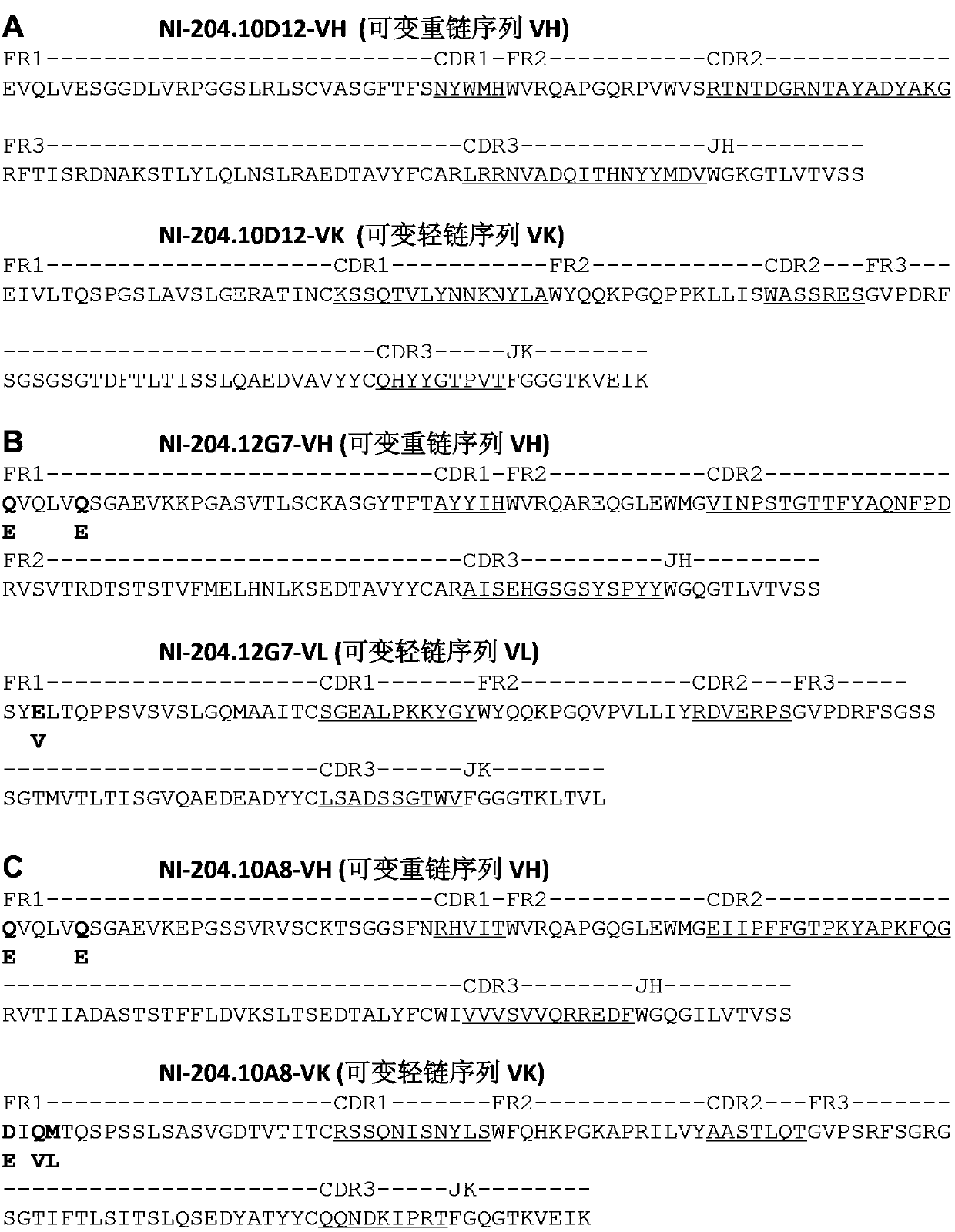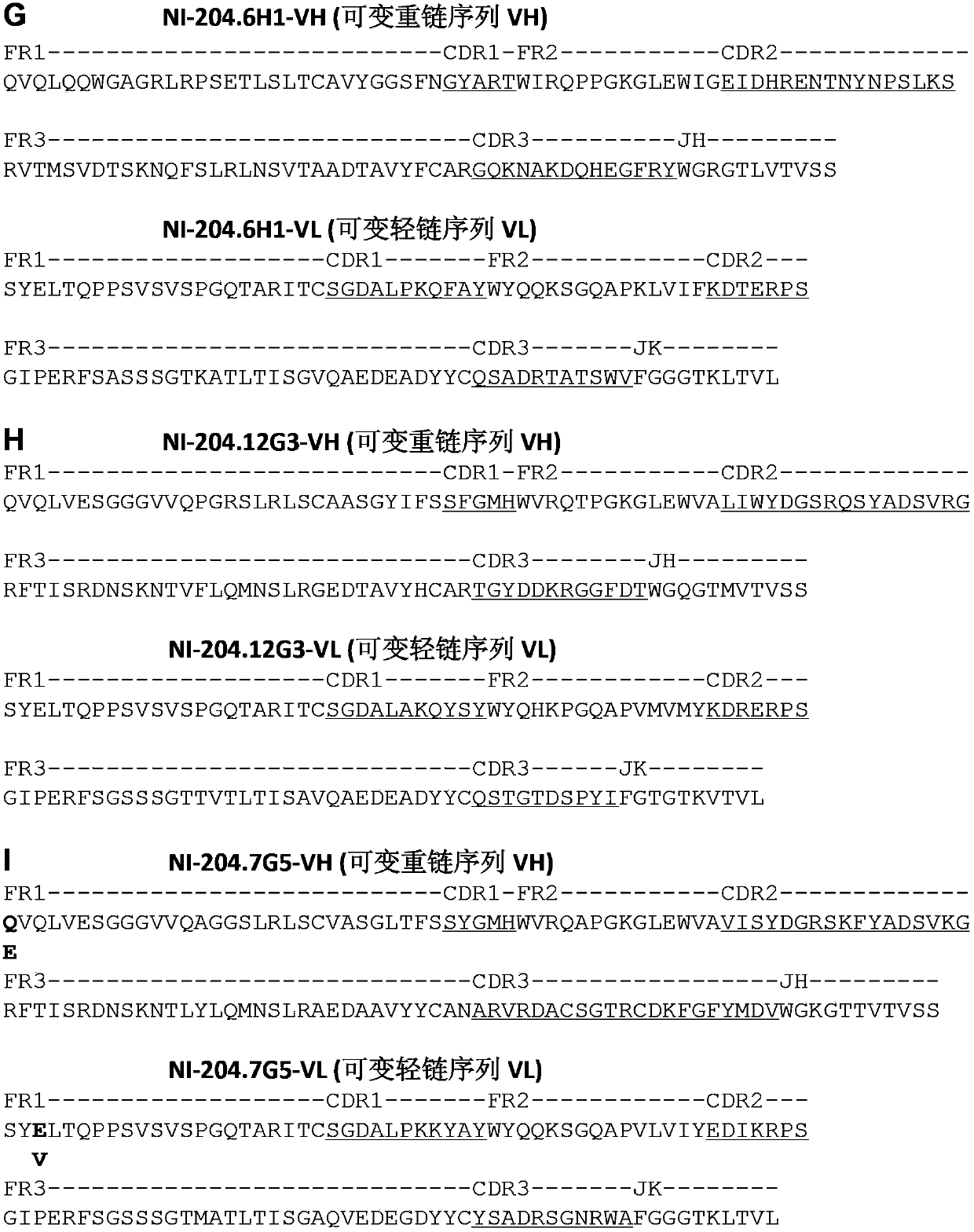Human anti-SOD1 antibodies
One-SOD1, SOD1 technology, applied in the field of human antibodies and their fragments, derivatives and variants, can solve the problem of unknown exact mechanism of SOD1 aggregation
- Summary
- Abstract
- Description
- Claims
- Application Information
AI Technical Summary
Problems solved by technology
Method used
Image
Examples
Embodiment 1
[0293] Example 1: Target Validation and Binding Specificity of Human SOD1-Antibodies
[0294] To validate SOD1 as a putative target for the isolated antibodies, a direct ELISA assay was performed as described above. For exemplary recombinant human NI-204.10D12, NI-204.12G7, NI-204.9F6 and NI-204.10A8 antibodies, 96-well microplates (Costar, Corning, USA) were prepared by mixing with recombinant human SOD1 (biomol, Hamburg, Germany) Or coated with BSA (Sigma-Aldrich, Buchs, Switzerland) diluted to a concentration of 3.3 μg / ml, in carbonate ELISA coating buffer (15 mM Na 2 CO 3 , 35mM NaHCO 3 , pH9.42), and tested the affinity of the antibody. Exemplary NI-204.10D12, NI-204.12G7, NI-204.9F6 and NI-204.10A8 antibodies specifically bind to human SOD1 by ELISA. No binding to BSA was observed; see figure 2 .
[0295] In order to determine the half maximal effective concentration (EC 50 ), additional direct ELISA experiments with different antibody concentrations were perform...
Embodiment 2
[0297] Example 2: EC 50 Analysis of coating concentrations for increasing human superoxide dismutase 1 (SOD1), thus preferentially forming conformational epitopes
[0298] To determine the binding capacity of NI-204.10D12, NI-204.10A8, NI-204.12G7 and NI-204.9F6 for conformational epitopes, direct ELISA experiments were performed using four different coatings in the coating buffer Human recombinant SOD1 (Biomol, Hamburg, Germany) at concentrations (0.1; 1; 10 or 30 μg / ml). Primary antibodies human NI-204.10D12, human NI-204.10A8, human NI-204.9F6 and mouse monoclonal antibody SOD-172B1 (Santa Cruz Biotechnology, Santa Cruz, USA) were diluted to the indicated concentrations ( Figure 4 ) and incubated for 1 hour at room temperature. Binding was determined using a goat anti-mouse IgG antibody (Jackson Immunological Research, Newmarket, UK) or a donkey anti-human IgGγ antibody conjugated to HRP (Jackson Immunological Research, Newmarket, UK), followed by a standard colorimetric...
Embodiment 3
[0302] Example 3: Binding analysis of physiological SOD1 dimers and misfolded / aggregated SOD1 in vitro
[0303] Metal-catalyzed oxidation reactions were used to induce superoxide dismutase 1 aggregates in vitro (according to Rakhit et al., J Biol Chem. 279 (2004), 15499-504). Wild-type SOD1 from human erythrocytes (dimers) and all other reagents were purchased from Sigma-Aldrich (Buches, Switzerland). For aggregation, 10 μM human SOD1 was incubated in 10 mM Tris-acetate buffer, pH 7.0, containing 4 mM ascorbic acid and 0.2 mM CuCl 2 , at 37 °C for 48 h. As a control, 10 μM human SOD1 was incubated in 10 mM tris-acetate buffer, pH 7.0, at 37°C for 48 hours.
[0304] In coating buffer (15mM Na 2 CO 3 , 35mM NaHCO 3 , pH 9.42), 96-well microplates (Corning) were coated with physiological human SOD1 dimer or in vitro pooled human SOD1 dimer. Non-specific binding sites were blocked for 1 hour at room temperature with PBS / 0.1% -20 with 2% BSA (Sigma-Aldrich, Buchs, Switzerla...
PUM
 Login to View More
Login to View More Abstract
Description
Claims
Application Information
 Login to View More
Login to View More - R&D
- Intellectual Property
- Life Sciences
- Materials
- Tech Scout
- Unparalleled Data Quality
- Higher Quality Content
- 60% Fewer Hallucinations
Browse by: Latest US Patents, China's latest patents, Technical Efficacy Thesaurus, Application Domain, Technology Topic, Popular Technical Reports.
© 2025 PatSnap. All rights reserved.Legal|Privacy policy|Modern Slavery Act Transparency Statement|Sitemap|About US| Contact US: help@patsnap.com



